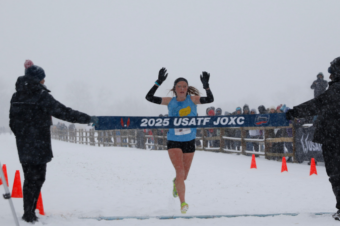

How To Transition From Summer Workouts To Fall Sports Training
BlogClub SportsClub SportsHealth & FitnessHigh School BasketballHigh School FootballMulti-SportNewsRunningXC-Track-Running August 19, 2024 Lauren Keating 0

Summertime allows for less structure—and that also may mean when it comes to training. Many athletes take a few weeks off in the summer to repair muscle and recover from spring-season sports. Those who remain active may focus on more playful summer sports to just keep fit and maintain their weekly training goals. Those who continue to train or attend specialized sports camps may have been focused on building strength and endurance.
But for high school and college athletes, the shift from summer workouts to fall sports training is an important and sometimes challenging transition. As fall sports season approaches, the emphasis shifts towards sport-specific skills, team dynamics, and competition readiness.
It’s important to transition to the physical workload and change in skills development coming from the summer to the fall to make sure athletes are easy for the fall sports season.
Here’s how to transition from summer workouts to fall sports.

1. Assess Your Summer Goal Progress
Athletes should always be setting new goals, both small and big. Now is the time to look at the summer goals (even if it was just to focus on recovery) and see if those goals are met. If not, remember there is still some time before fall sports start. Now is the time to get your head in the game.
Did you increase your strength? Improve your endurance? Did you enhance your speed and agility?
Understanding your current fitness level will help you identify areas that still need improvement and allow you to tailor your fall training to meet those needs.
2. Start To Shift Focus to Sport-Specific Skills
Summer workouts often emphasize general fitness, including strength, conditioning, and flexibility. As you transition to fall sports, it’s important to shift your focus to sport-specific skills. For example, if you’re a soccer player, you should start incorporating more passing, and shooting drills into your routine. Football players should focus on position-specific drills, while cross country runners might start integrating more hill work and tempo runs.
3. Increase the Intensity and Frequency of Practice
As fall sports season approaches, structured practices are on the calendar. Keep in mind when transitioning to fall training that practices are to become more frequent and intense. During the summer, you may have worked out a few times a week with plenty of rest days in between. Fall training often demands daily practice, sometimes even multiple sessions per day. This increase in intensity and frequency can be tough on your body, so it’s important to adjust gradually.
A great tip is to use the last bit of the summer to start to lightly increase either workout intensity or frequency leading up to the start of the fall season. To do so, add in a strength training workout on cardio days. Switch to a high-intensity workout to amp things up. If your sport often has twice-a-day practice, start to incorporate twice-a-day workouts at least once a week and slowly increase the times per week if able. This could mean an early morning run followed by a gym session later in the day.
4. Recovery Is Still Key For Injury Prevention
Athletes know that recovery is always important when it comes to staying in top-performance shape. Remember that with the increase in training volume comes an increased risk of injury. As you transition to fall sports, it’s essential to prioritize recovery and injury prevention. This means paying attention to your body’s signals and not pushing through pain that could indicate an injury.
To prevent injury transiting to a more structured and intense fall training plan, make sure to always start with a proper warm-up and cool-down with every workout. Stretching, foam rolling, and using techniques like ice baths or compression can help reduce muscle soreness and prevent injuries. Adequate sleep, hydration, and nutrition are also critical to support your body through this demanding period.
If you feel persistent pain or discomfort, it’s important to address it early. Ignoring minor injuries can lead to more serious issues that could sideline you for the season. Consider working with your coach or a physical therapist to address any areas of concern.
READ RELATED: 7 Simple And Effective Strength Training Exercises For Fall Sports
5. Focus on Mental Prep
The mental shift from summer workouts to fall sports is just as important as the physical transition. During the summer, you may have trained independently or in small groups. Those who went to camps may find that it was a balance of structured workouts that were more intensive and followed by lots of leisure time.
Fall sports bring the added pressure of team dynamics, competition, and the expectation to perform at a high level.
Start preparing mentally by setting specific goals for the fall season. This could be Whether it’s improving a particular skill, earning a position, or helping the team with their first big win, having clear objectives helps to keep athletes motivated and focused. Visualization techniques, where you mentally rehearse successful performance scenarios, can also be a powerful tool in preparing for the competitive season.
Additionally, work on developing a positive mindset. Embrace the challenges and pressures of the season as opportunities to grow and improve. Remember, mental toughness is a key component of athletic success, and your attitude can greatly influence your performance.
6. Communicate With Your Coaches
As you make the transition, maintain open communication with your coaches. Coaches provide valuable insights into training goals, and progress, and offer advice on how to adjust training plans as you shift into fall sports mode. Don’t hesitate to ask for feedback or guidance on specific areas you’re looking to improve.
By keeping your coaches informed about how you’re feeling physically and mentally, you can work together to develop a training plan that optimizes your performance while minimizing the risk of burnout or injury.
Conclusion
Transitioning from summer workouts to fall sports training is a crucial phase in preparing for a successful season. Remember to gradually shift your focus and workout plans to slowly increase intensity. Keep recovery as a major part of any weekly training plan and maintain mental readiness.
The trick to safely transition training focus is to do so gradually. Integrate these sport-specific activities into your training instead of completely switching up your summer workout routine entirely. The goal here is to blend the two to create a balanced program that maintains your general fitness while starting to put the spotlight on the skills required for your sport.









No comments so far.
Be first to leave comment below.